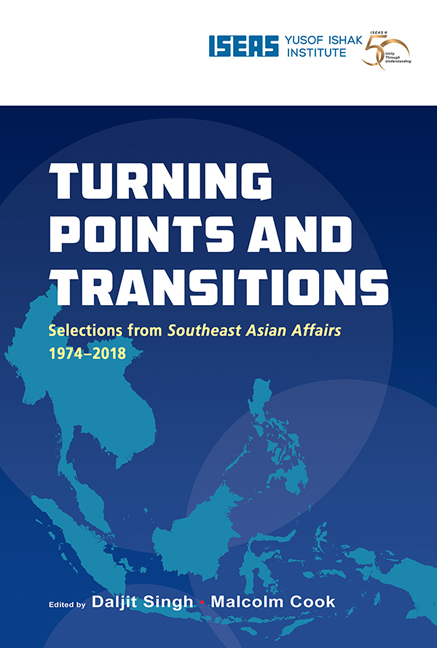Book contents
- Frontmatter
- Contents
- Message from the Director
- Foreword
- Foreword
- Introduction
- THE REGION
- BRUNEI
- CAMBODIA
- INDONESIA
- LAOS
- MALAYSIA
- MYANMAR
- Burma in 1988: Perestroika with a Military Face (1989)
- Myanmar 1990: New Era or Old (1991)
- Myanmar: No Turning Back (2012)
- Myanmar's General Election 2015: Change was the Name of the Game (2016)
- THE PHILIPPINES
- SINGAPORE
- THAILAND
- VIETNAM
Burma in 1988: Perestroika with a Military Face (1989)
from MYANMAR
Published online by Cambridge University Press: 29 May 2019
- Frontmatter
- Contents
- Message from the Director
- Foreword
- Foreword
- Introduction
- THE REGION
- BRUNEI
- CAMBODIA
- INDONESIA
- LAOS
- MALAYSIA
- MYANMAR
- Burma in 1988: Perestroika with a Military Face (1989)
- Myanmar 1990: New Era or Old (1991)
- Myanmar: No Turning Back (2012)
- Myanmar's General Election 2015: Change was the Name of the Game (2016)
- THE PHILIPPINES
- SINGAPORE
- THAILAND
- VIETNAM
Summary
CONTEXTS FOR CHANGE
Nineteen eighty-eight marks a system break in Burma's modern history. To understand the significance of the events of the year we should set them in two different contexts. One is the context of states with command economies and Leninist parties which have undertaken perestroika with or without glasnost. The polar reform cases include the Chinese model, with economic liberalization starting in agriculture and politics being restrained after an initial opening, and the Soviet model, with economic liberalization attempted across the board and political openness encouraged as a spur to the perestroika process. These models offer only a partial context for our understanding of Burma since in both instances the movement can be characterized as reform rather than revolution: while there are significant redistributions of power and authority among state institutions and between state and society, and there are changes in external relations as well, still the basic legitimacy of the system remains in place, élite replacement is moderate, and the level of violence and coercion is low.
The other context is Burma's own cycles of reform and revolution during the last half century as shown below. (The numerologically inclined will note a periodicity of about a dozen years — actually 13.67 plus or minus 0.83 years.)
THE POLITY IN 1988
While the operative effects of any changes in direction for the economy during 1988 were obscure, political changes verged on revolution. The level of violence was high, the legitimacy of the regime collapsed, and the ruling élite, while maintaining its core institution, the army, went through a complete change of personnel at the top. Before analysing these fundamental changes, the chronological line of action will first be set out.
Chronology of the Crisis
The system break of 1988 began in March with a tempest in a teashop which grew into a full-scale student riot and brought on full-scale police repression. In contrast to the previous fall's student protests over demonetization, this series of riots spread to downtown Rangoon. The stage for public protest had been set by spiralling inflation and a shortage of fuel for transport, which left some areas of the country, and particularly the cities, short of rice.
- Type
- Chapter
- Information
- Turning Points and TransitionsSelections from Southeast Asian Affairs 1974-2018, pp. 477 - 493Publisher: ISEAS–Yusof Ishak InstitutePrint publication year: 2018



